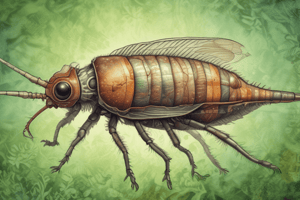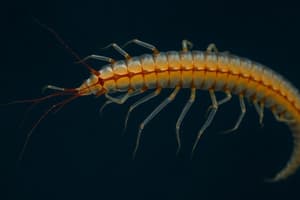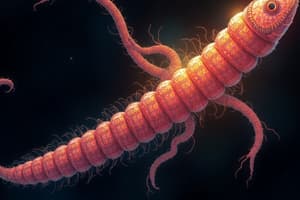Podcast
Questions and Answers
Ingestion of Taenia solium eggs by humans can lead to cysticercosis. Which biological mechanism explains how the parasite establishes infection outside of the intestinal tract?
Ingestion of Taenia solium eggs by humans can lead to cysticercosis. Which biological mechanism explains how the parasite establishes infection outside of the intestinal tract?
- The eggs induce an inflammatory response in the intestine, which increases the permeability of the intestinal wall, allowing the intact eggs to enter the bloodstream.
- The eggs directly attach to the intestinal lining and release toxins that facilitate their transport across the epithelial barrier into the lymphatic system.
- The eggs produce enzymes that degrade the intestinal mucosa, enabling them to directly invade the submucosa and disseminate through the enteric nervous system.
- The eggs hatch in the intestine, releasing oncospheres that penetrate the intestinal wall and migrate via the bloodstream to various tissues where they develop into cysticerci. (correct)
How does the lifecycle of Taenia saginata differ primarily from that of Taenia solium?
How does the lifecycle of Taenia saginata differ primarily from that of Taenia solium?
- _T. saginata_ relies on cattle as an intermediate host, and _T. solium_ uses pigs. (correct)
- Only _T. solium_ can cause cysticercosis in humans, whereas _T. saginata_ does not.
- _T. saginata_ infects humans through the consumption of undercooked pork, while _T. solium_ infects through beef.
- _T. saginata_ utilizes pigs as an intermediate host, while _T. solium_ uses cattle.
What is the primary mechanism by which praziquantel is effective in treating Taenia infections?
What is the primary mechanism by which praziquantel is effective in treating Taenia infections?
- Inhibiting the parasite's glucose uptake, leading to energy depletion.
- Blocking the neuromuscular junctions, causing paralysis and detachment of the worm.
- Interfering with the parasite's DNA replication, preventing further growth.
- Disrupting the tegument of the worm, leading to calcium influx and paralysis. (correct)
A patient is diagnosed with neurocysticercosis. Which of the following best describes the pathogenesis of this condition?
A patient is diagnosed with neurocysticercosis. Which of the following best describes the pathogenesis of this condition?
Which structural feature is present in Taenia solium but absent in Taenia saginata, contributing to differences in their pathogenesis or identification?
Which structural feature is present in Taenia solium but absent in Taenia saginata, contributing to differences in their pathogenesis or identification?
Why is cysticercosis associated exclusively with Taenia solium and not with Taenia saginata?
Why is cysticercosis associated exclusively with Taenia solium and not with Taenia saginata?
What is the significance of identifying the number of uterine branches in the proglottids of Taenia species?
What is the significance of identifying the number of uterine branches in the proglottids of Taenia species?
Which statement accurately contrasts the infectious stages of Taenia saginata and Taenia solium?
Which statement accurately contrasts the infectious stages of Taenia saginata and Taenia solium?
In regions where both beef and pork tapeworms are prevalent, which public health intervention would be most effective in preventing both taeniasis and cysticercosis?
In regions where both beef and pork tapeworms are prevalent, which public health intervention would be most effective in preventing both taeniasis and cysticercosis?
A patient presents with seizures and is found to have multiple lesions in the brain. An MRI confirms a diagnosis of neurocysticercosis. Besides praziquantel, what additional treatment should be considered to directly address the neurological symptoms?
A patient presents with seizures and is found to have multiple lesions in the brain. An MRI confirms a diagnosis of neurocysticercosis. Besides praziquantel, what additional treatment should be considered to directly address the neurological symptoms?
Flashcards
Cysticercosis
Cysticercosis
A parasitic infection caused by the larval stage of the pork tapeworm, Taenia solium, when humans ingest the eggs.
Definitive Host (Taenia)
Definitive Host (Taenia)
Humans harboring the adult form of Taenia saginata (beef tapeworm) or Taenia solium (pork tapeworm).
Intermediate Host (Taenia)
Intermediate Host (Taenia)
Cattle for Taenia saginata, pigs for Taenia solium; where the larval stage (cysticerci) develops.
Cysticercosis Development
Cysticercosis Development
Signup and view all the flashcards
Location of Adult Tapeworm
Location of Adult Tapeworm
Signup and view all the flashcards
Transmission of Taenia saginata
Transmission of Taenia saginata
Signup and view all the flashcards
Symptoms of Intestinal Taeniasis
Symptoms of Intestinal Taeniasis
Signup and view all the flashcards
Treatment for Taeniasis
Treatment for Taeniasis
Signup and view all the flashcards
Diagnosis of Taeniasis
Diagnosis of Taeniasis
Signup and view all the flashcards
Taenia solium Scolex
Taenia solium Scolex
Signup and view all the flashcards
Study Notes
- Platyhelminthes are flatworms, including Cestodes like Taenia saginata and Taenia solium.
Taenia Saginata (Beef Tapeworm)
- The beef tapeworm's definitive host is humans harboring the adult form.
- Intermediate hosts are cattle, which carry the larval stage.
- Humans get it by eating raw/undercooked beef.
- Humans experience intestinal symptoms.
- The adult form of the tapeworm lives in the small intestine of humans, especially the jejunum.
- The scolex has four oral suckers and no rostellum or hooklets.
- This species features a longer neck.
- There are 1,000–2,000 proglottids (segments).
- The uterus has more than 13 branches.
- Two ovaries are present, without an accessory lobe.
- The worms grow up to 5 meters.
Taenia Solium (Pork Tapeworm)
- The pork tapeworm's definitive host is humans harboring the adult form.
- Intermediate hosts are pigs, which carry the larval stage.
- Humans can be accidental intermediate hosts, leading to cysticercosis.
- Humans get it by eating raw/undercooked pork.
- Humans experience intestinal and neurological symptoms.
- The adult form resides in the human small intestine.
- Its scolex has four suckers, with a rostellum and two rows of hooklets.
- The neck is shorter in length.
- There are 800–2,000 proglottids (segments).
- It has 12 major uterine branches.
- The species has two ovaries with an accessory lobe.
- Worms grow 2–7 meters in length.
Taenia Species Life Cycle
- The two species have a similar life cycle, differing only in the intermediate host.
- Eggs or gravid proglottids pass through human feces and can survive in the environment for days to months.
- Cattle (for T. saginata) or pigs (for T. solium) ingest contaminated vegetation.
- In the animal intestine, oncospheres hatch, penetrate the intestinal wall, and migrate to striated muscles, where they develop into cysticerci (larvae).
- Humans get infected by eating raw or undercooked infected meat.
- In the human intestine, the cysticercus develops into an adult tapeworm in ~2 months and can survive for years.
- The adult tapeworm attaches to the small intestine and produces gravid proglottids, which detach and are excreted in feces, continuing the cycle.
Taenia solium and Cysticercosis
- Cysticercosis occurs when humans accidentally ingest Taenia solium eggs.
- Intestinal taeniasis is caused by ingesting larvae.
- Cysticercosis occurs from contaminated food, water, or by fecal-oral transmission from an infected person.
- Eggs are immediately infectious, without an external development period.
- Once ingested, oncospheres hatch, penetrate the intestinal wall, and enter the bloodstream.
- They migrate to various tissues, including muscles, eyes, skin, and brain, where they form cysticerci (larvae).
- If cysticerci reach the central nervous system (CNS), they cause neurocysticercosis, which can lead to: seizures, headaches, hydrocephalus, neurological deficits.
Additional Information
- The parasite exists in three stages: adult worm, larvae, and eggs.
- The larval stage is infectious to humans and eggs are infectious to cattle.
- Both species cause intestinal taeniasis, with symptoms like abdominal discomfort, indigestion, nausea, diarrhea, and weight loss.
- T. solium larvae can invade different tissues and cause severe complications, including neurocysticercosis if they reach the brain.
- Praziquantel is used for treatment.
- Diagnosis is achieved by observing eggs or gravid proglottids in the stool.
Studying That Suits You
Use AI to generate personalized quizzes and flashcards to suit your learning preferences.




